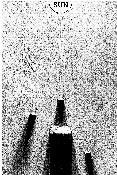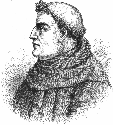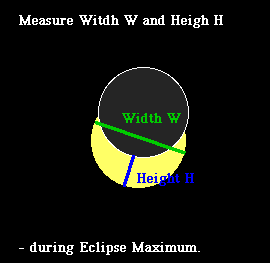 |
 |
On Saturday October 12th a quite rare phenomenon will occur; a partial solar eclipse. This eclipse will be visible from Northern Canada, all Europe and Northern Africa.

A solar eclipse takes place when the Moon, during its revolution around the Earth, happens to be positioned between the Earth and the Sun. When seen from certain regions on the Earth, it covers (part of) the solar disc. Such events occur at New Moon, but not at every New Moon - most often the Moon passes too far above or below the (imaginary) line that connects the Sun with Earth.
A solar eclipse is total if there are regions where the Moon's shadow hits the Earth's surface. There, the Moon's disc is seen to cover completely that of the Sun and for some minutes the sky becomes dark during daytime. At a site outside this region, the Moon will not cover the Sun entirely and the daylight will only dim a little.
A solar eclipse is said to be partial, when the Moon's shadow just misses the Earth. In this case, there are no regions from where the Sun will be completely covered.
A third possibility is an annular (ring-shaped) eclipse. This happens when the Moon is comparatively far from the Earth (the Moon's orbit is elliptical) and the Moon's shadow does not reach all the way to the surface of the Earth. In those regions that are situated beyond the end of the shadow cone, the edge of the Sun's disc can be seen around that of the Moon; hence the name of this type of eclipse.
The solar eclipse on October 12, 1996, belongs to the second category and is partial. Thus, there will be no places on Earth where the sunlight will disappear entirely. Nevertheless, this event is a very impressive spectacle, as the Moon's disc is seen to move gradually across that of the Sun.
We suggest that interested Astronomy On-Line participants should observe this phenomenon and, in particular, try to perform some simple measurements indicated below. When combined, these measurements may allow us to give a reliable determination of the distance and the size of the Moon. This would probably be the first time such a measurement is done by a concerted programme with so many young participants!
Added on October 11: Various new information about activities around this solar eclipse is now also available in Astronomy On-Line Newspaper no. 02. The is also a Special Issue of the Bulletin with all links, especially to those sites where you may be able to obtain live images of the eclipse.
Added on October 24: A A Provisional Summary of Results is available.

This is a nice picture taken during an earlier partial solar eclipse. Click on it, if you want to see a larger version (GIF, 16k)
In case you would like to know more about an interesting aspect of solar eclipses, have a look at the historical notes, included here.
This partial solar eclipse will take place 2 - 4 hours after noon, on Saturday Oct. 12th 1996.

In Europe, 30 to 70 percent of the Sun will become eclipsed. This means that the Moon's disc covers 30 to 70 percent of the total area of the Sun's disc. You may find the percentage at your location from map markings above. For instance, in Southern Germany and Northern France, about 0.6 or 60 percent of the Sun will be covered, while it will be somewhat less, about 40 percent, in Southern Spain. The further north you are, the more of Sun will be eclipsed.
Another version of such a map is available by clicking here (GIF, 40k) (Sky & Telescope; in colour).

Occasionally, our Moon passes in front of our planet (Click on image to get a larger version (GIF, 43k) and gives rise to a shadow. On October 12, 1996, this shadow will rush across Northern Canada and the European continent.
Interestingly, this eclipse is a forerunner of the total eclipse that will take place on August 11, 1999. On this day, Europe will experience its first total eclipse for 38 years. The Moon's shadow will rush across the southernmost part of the United Kingdom and cross France, Germany, Austria, Hungary, Romania, the Black Sea, Turkey, and onwards into Asia.
The European Association for Astronomy Education (EAAE) is planning to set up a comprehensive programme for observation of the 1999 eclipse. The present observations, three years earlier, will help to do this in the best possible way.
In Europe, the eclipse on October 12 will reach its maximum around 1600 - 1700 hours Central European Summer Time (CEST), depending on where you live. More detailed information about when the maximum occurs may be found in a Sky & Telescope Eclipse Article. Note, however, that the times in this article are given in Universal Time (UT). Since CEST = UT + 2 hours, most European observers must add 2 hours to obtain the timing in CEST. (In earlier years, the summer time period in Europe ended in late September; this year, the period has been prolonged by one month.)
Further information about this eclipse may be found at the NASA Homepage: "Solar Eclipse paths: 1995-2005".
All observers, whether teachers, students, amateur or professional astronomers, must remember NEVER EVER TO LOOK THROUGH AN UNSHIELDED TELESCOPE AIMED AT THE SUN! The famous Italian scientist Galileo unfortunately did so and became blind. With our present high-transmission telescopes, eye damage will occur within less than a second. The tremendous heating power of sunlight is easily demonstrated using a magnifying lens (a burning glass).
There are however quite a few, easy and safe methods available by which you can observe a solar eclipse without any risk.
Some of the very first cameras contained no lenses but were only equipped with a pinhole.

Strictly speaking, this camera is nothing more than a black box with one hole in the front.

Light travels in straight lines and therefore rays from the Sun will hit the back of the box and create a perfect image of the Sun's disc. Click on the drawing above to get a larger image (GIF, 37k).
It is possible to use this black box as a general camera, not only for photographing the Sun but also for taking ordinary photographs. These black box cameras are easy to construct, but often require long exposure times due to the small aperture.
This method was even used by French artists painting miniatures during the 18th century. Could you imagine spending a whole day painting miniature copies inside a warm black box like this?

Originally the Pin Hole Camera was invented by an English monk, Roger Bacon (1220-1292); click on the image for a larger one (GIF, 44k). Roger Bacon's research was considered by his contemporaries as being witchcraft and he spent half his life in prison.
For our project, however, this camera is safe, legal and simple!
The Sun's image inside our box will undergo all the phases of the eclipse, just like the real Sun. This method is safe and may even be carried out by rather young children in groups.
Here are a few hints: 1. The light hole needs to be small in order to get a sharp image - diameters around 1 mm are sufficient. 2. The box must be about 0.6-1 metres long in order to get a reasonably large image.
During the EAAE Conference at ESO in November 1994, the Spanish Teachers presented nice results which were obtained with this Black Box Method. As a dark box, they had used huge cardboard tubes. Such 4 metre long tubes may be picked up, often for free, at storehouses selling carpets.
The size of the Sun's image will be around 1 percent of the box length. A 4 metre tube may thus give a very reasonable solar disc size of about 4 cm.

Do you know that this pinhole effect may also be seen in nature? A leafy forest may absorb almost all the sunlight, only leaving a few rays to pass through occasional holes. The effect visible on the ground will be like this:
If you want to see more details, click on the image, but beware that it is quite large (JPG, 136 k) and the transfer may take some time.
So during the October 12 eclipse you may observe eclipsed solar discs scattered all around the forest floor.
During the month of October, these mini-Suns will have an elliptical shape. The Sun's disc is of course still circular, and the elliptical shape is only an effect of the projection. If sunlight came from straight above ('Zenith'), the solar images projected on the ground would all look perfectly circular. But in October, the Sun never reaches Zenith in Europe, only in countries south of the Earth's equator.
The mirror method is actually a very interesting variation of Francis Bacon's 700-year old Pin Hole Camera. Instead of letting the sunlight pass through a small hole, this method reflects the light back into, for example, a northern, shady classroom.
Besides being totally safe, this method works well when long distances are used.
A small dentist's mirror, placed about 10 metres away, results in a solar image which is approximately 10 cm in diameter. A larger mirror may still be used, if you cover unused parts with tape or paper.

This binocular method will also give remarkable results. You can see on the figure how it works.
Once again: Do remember and explain to your friends that they MUST NEVER AIM AN UNSHIELDED SCOPE DIRECTLY AT THE SUN ! AND DON'T LEAVE THE TELESCOPE UNATTENDED!
This method is often described in books and magazines, but is still dangerous for several reasons. Read this carefully:
Many years ago, film plates used silver nitrate. An over-exposed film plate would thus provide an effective metallic shield, similar to the shields used by astronauts in space in front of their helmets.
Nowadays, however, most plastic films are made of other materials and do not give any protection against solar infrared rays. The same problem occurs with unauthorised welding glasses.
In Sky & Telescope (July 1991, page 80), you will find these comments: One filter entirely safe for direct solar viewing is a shade 14 rectangular welder's glass. It transmits only 1 part in 370,000 of the incident light and meets strict tolerances on transmission of invisible infrared and ultraviolet as well. This costs only a few dollars, but be sure you get the right item.
If you have a good school telescope, be sure to buy a proper optical solar filter. Mounted correctly in front of a telescope this will give a most impressive picture. Several brands are available and prices vary from about 8 ECU's and upwards.
Plastic Mylar filters are cheapest, but seem to be extremely fragile and some only transmit a strange, blue colour. Glass filters are available too, with prices around 30 ECU. These transmit nice colours and beautiful photographs are possible.
For details of where to buy, take a look and compare prices in astronomical magazines such as Astronomy or Sky & Telescope.
Warning : Never use ordinary sun glasses in front of your telescope. Some of these cheap filter glasses have 100% transmission in the invisible infrared, again exposing your eye to lifelong damage.
Some companies sell solar filters designed to be mounted as an eyepiece. Avoid these products! One of our students once mounted such an eyepiece solar filter in his telescope. He aimed his instrument directly at the Sun. 40 seconds of sunlight were enough and this eyepiece cracked into pieces! A bad investment!
If you decide to participate in this collaborative project within the Astronomy On-Line programme, you will want to know how to perform the observations in such a way that they become useful for the project.
You may choose between two different methods. One is the 2-dimensional method described below and for which the mathematical concepts are available on a separate page. The other is the 3-dimensional method, which is somewhat more demanding.
Both methods have their positive and negative sides - which model you choose is up to you. However, by evaluating these different working methods, we may achieve valuable experience for the best possible planning of the student observations which will take place in connection with the 1999 total eclipse in Europe.
If you choose to use the 2-dimensional method for the partial eclipse on October 12, 1996, you should follow the eclipse as long as practically feasible. Make continuous measurements of both the Width W and the Height H, as these are indicated in the figure below:

Write these values as well as the time down, say every 5 minutes. While doing so, calculate the fraction of H/W and make a graph of H/W (y-axis) versus time (x-axis).
On this graph, estimate the lowest possible H/W-value. It occurs at the time of the eclipse maximum. Then determine the time of the maximum as accurately, as you can.
Note: It may help to sketch the Sun's circular outline on your paper before you start.
Click on the line below in order to see what information you should mail to us as soon as possible after the eclipse:
Please send your report by email to the European Student Project Group - by clicking, you will get the mailserver.
We will then begin to work on the observations submitted by the groups as soon as possible. When, after some days, most of the measurements have been received, we shall display it in an article in the Astronomy On-Line Newspaper with further details about the subsequent work to be done.
Remember, from these measurements, it may become possible to determine the distance and the size of the Moon!
Good luck and have a nice hunt!
The Solar Eclipse Group expresses their thanks to Patrick Poitevin, Joe Jordan, Eva Thisted and many others for most valuable comments and suggestions. Our thanks are also due to Frank Roussel, Universite de Rennes (France), for permission to reproduce the eclipse map in this student project.